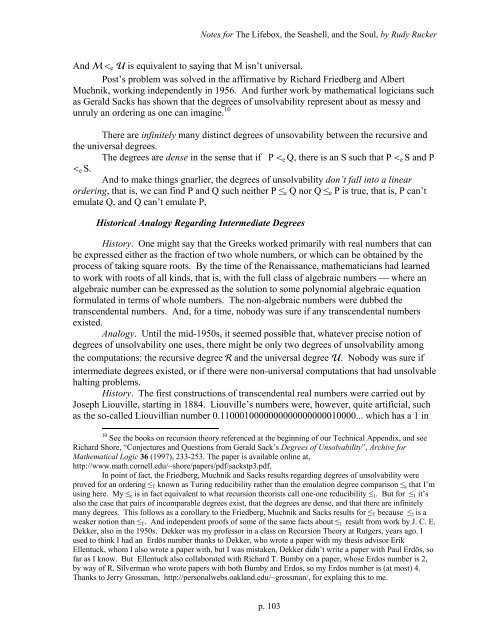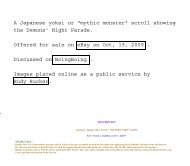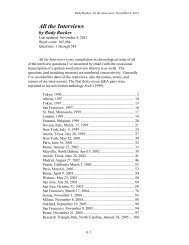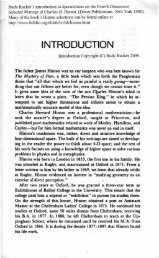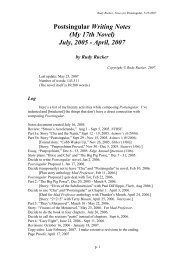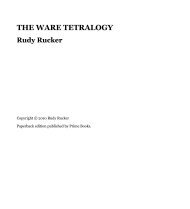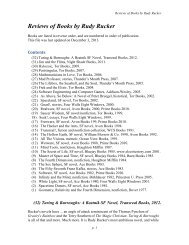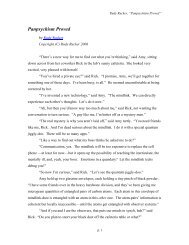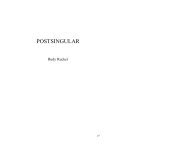Notes for the Lifebox, the Seashell, and the Soul - Rudy Rucker
Notes for the Lifebox, the Seashell, and the Soul - Rudy Rucker
Notes for the Lifebox, the Seashell, and the Soul - Rudy Rucker
You also want an ePaper? Increase the reach of your titles
YUMPU automatically turns print PDFs into web optimized ePapers that Google loves.
<strong>Notes</strong> <strong>for</strong> The <strong>Lifebox</strong>, <strong>the</strong> <strong>Seashell</strong>, <strong>and</strong> <strong>the</strong> <strong>Soul</strong>, by <strong>Rudy</strong> <strong>Rucker</strong><br />
And < e is equivalent to saying that M isn’t universal.<br />
Post’s problem was solved in <strong>the</strong> affirmative by Richard Friedberg <strong>and</strong> Albert<br />
Muchnik, working independently in 1956. And fur<strong>the</strong>r work by ma<strong>the</strong>matical logicians such<br />
as Gerald Sacks has shown that <strong>the</strong> degrees of unsolvability represent about as messy <strong>and</strong><br />
unruly an ordering as one can imagine. 10<br />
There are infinitely many distinct degrees of unsovability between <strong>the</strong> recursive <strong>and</strong><br />
<strong>the</strong> universal degrees.<br />
The degrees are dense in <strong>the</strong> sense that if P < e Q, <strong>the</strong>re is an S such that P < e S <strong>and</strong> P<br />
< e S.<br />
And to make things gnarlier, <strong>the</strong> degrees of unsolvability don’t fall into a linear<br />
ordering, that is, we can find P <strong>and</strong> Q such nei<strong>the</strong>r P ≤ e Q nor Q ≤ e P is true, that is, P can’t<br />
emulate Q, <strong>and</strong> Q can’t emulate P,<br />
Historical Analogy Regarding Intermediate Degrees<br />
History. One might say that <strong>the</strong> Greeks worked primarily with real numbers that can<br />
be expressed ei<strong>the</strong>r as <strong>the</strong> fraction of two whole numbers, or which can be obtained by <strong>the</strong><br />
process of taking square roots. By <strong>the</strong> time of <strong>the</strong> Renaissance, ma<strong>the</strong>maticians had learned<br />
to work with roots of all kinds, that is, with <strong>the</strong> full class of algebraic numbers ⎯ where an<br />
algebraic number can be expressed as <strong>the</strong> solution to some polynomial algebraic equation<br />
<strong>for</strong>mulated in terms of whole numbers. The non-algebraic numbers were dubbed <strong>the</strong><br />
transcendental numbers. And, <strong>for</strong> a time, nobody was sure if any transcendental numbers<br />
existed.<br />
Analogy. Until <strong>the</strong> mid-1950s, it seemed possible that, whatever precise notion of<br />
degrees of unsolvability one uses, <strong>the</strong>re might be only two degrees of unsolvability among<br />
<strong>the</strong> computations: <strong>the</strong> recursive degree <strong>and</strong> <strong>the</strong> universal degree . Nobody was sure if<br />
intermediate degrees existed, or if <strong>the</strong>re were non-universal computations that had unsolvable<br />
halting problems.<br />
History. The first constructions of transcendental real numbers were carried out by<br />
Joseph Liouville, starting in 1884. Liouville’s numbers were, however, quite artificial, such<br />
as <strong>the</strong> so-called Liouvillian number 0.1100010000000000000000010000... which has a 1 in<br />
10 See <strong>the</strong> books on recursion <strong>the</strong>ory referenced at <strong>the</strong> beginning of our Technical Appendix, <strong>and</strong> see<br />
Richard Shore, “Conjectures <strong>and</strong> Questions from Gerald Sack’s Degrees of Unsolvability”, Archive <strong>for</strong><br />
Ma<strong>the</strong>matical Logic 36 (1997), 233-253. The paper is available online at,<br />
http://www.math.cornell.edu/~shore/papers/pdf/sackstp3.pdf.<br />
In point of fact, <strong>the</strong> Friedberg, Muchnik <strong>and</strong> Sacks results regarding degrees of unsolvability were<br />
proved <strong>for</strong> an ordering ≤ T known as Turing reducibility ra<strong>the</strong>r than <strong>the</strong> emulation degree comparison ≤ e that I’m<br />
using here. My ≤ e is in fact equivalent to what recursion <strong>the</strong>orists call one-one reducibility ≤ 1 . But <strong>for</strong> ≤ 1 it’s<br />
also <strong>the</strong> case that pairs of incomparable degrees exist, that <strong>the</strong> degrees are dense, <strong>and</strong> that <strong>the</strong>re are infinitely<br />
many degrees. This follows as a corollary to <strong>the</strong> Friedberg, Muchnik <strong>and</strong> Sacks results <strong>for</strong> ≤ T because ≤ 1 is a<br />
weaker notion than ≤ T . And independent proofs of some of <strong>the</strong> same facts about ≤ 1 result from work by J. C. E.<br />
Dekker, also in <strong>the</strong> 1950s. Dekker was my professor in a class on Recursion Theory at Rutgers, years ago. I<br />
used to think I had an Erdös number thanks to Dekker, who wrote a paper with my <strong>the</strong>sis advisor Erik<br />
Ellentuck, whom I also wrote a paper with, but I was mistaken, Dekker didn’t write a paper with Paul Erdös, so<br />
far as I know. But Ellentuck also collaborated with Richard T. Bumby on a paper, whose Erdos number is 2,<br />
by way of R. Silverman who wrote papers with both Bumby <strong>and</strong> Erdos, so my Erdos number is (at most) 4.<br />
Thanks to Jerry Grossman, http://personalwebs.oakl<strong>and</strong>.edu/~grossman/, <strong>for</strong> explaing this to me.<br />
p. 103


